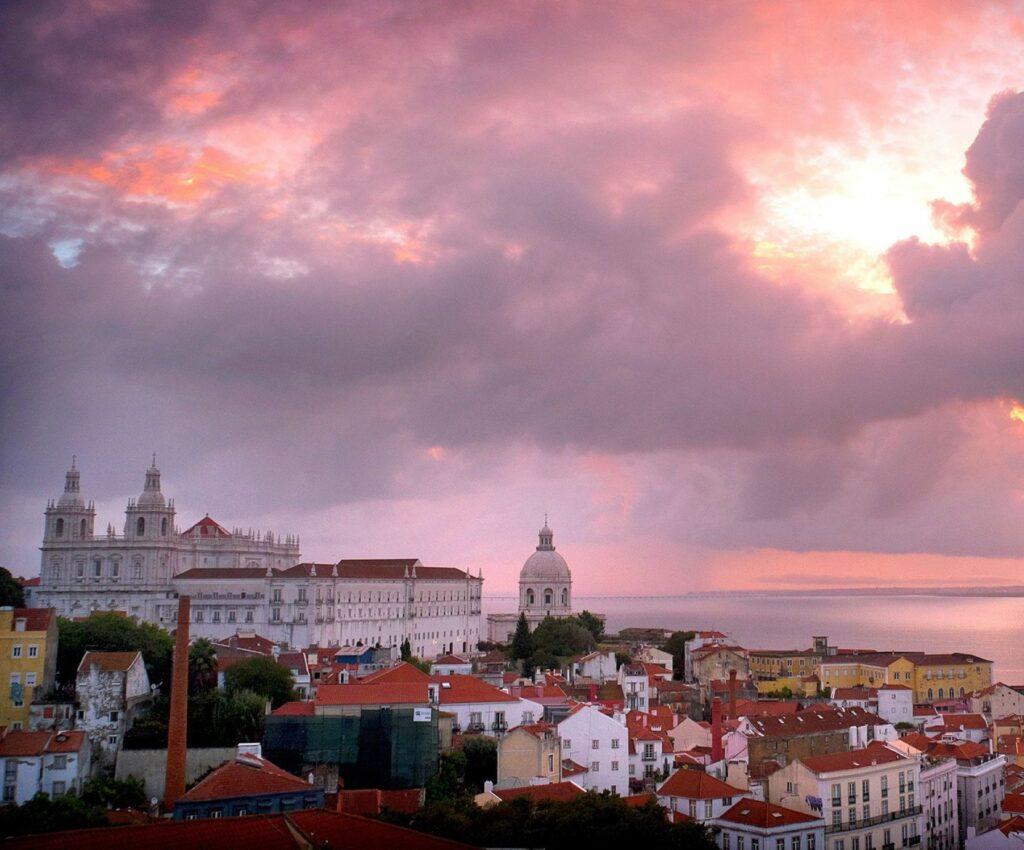Each day, thousands of pastéis de nata are baked and sold in Lisbon. Locals eat their pastry with a coffee in the morning. Tourists queue for hours to buy boxes at shops like Antiga Confeitaria de Belém.
But Portugal’s most iconic pastry is the size of a pea in a country with a vast tradition of sweets. Each one is different in volume, sweetness, and color. There are palm or king-sized; sweet or mellow; yellow, brown or white.
You find these pastries at pastelarias, neighborhood cafés with glassed counters, where you pick your favorite: pastel de nata (egg custard), queque (muffin), bola de Berlim (Portuguese doughnuts), xadrez (checkerboard cake), pão de Deus (brioche with coconut on top), mil-folhas (millefeuille).
“Sugar was produced in Portugal,” said Cristina Castro, the director of “No Ponto,” a research project with the aim of cataloging Portugal’s sweets. “It became available to locals, and as soon as it was mixed with egg yolks, pastry recipes proliferated. While sweets “meant coziness, they also meant health,” she said. “Nuns would make rice pudding to treat people ill with tuberculosis.”
Portuguese eat sweets for breakfast, mid-morning, after lunch, or in the evening. Or anytime they are craving a snack. Here are five worth trying out next time you visit Lisbon.
Guardanapo

Portuguese sweet recipes evolved over centuries. Pastries were calibrated when a new technique was discovered or ingredients were missing. Guardanapos (napkins in Portuguese) were first made with cake scraps as an adaptation of tortas (Portuguese Swiss rolls). They are fluffy egg yolk sponge cakes in a triangular shape filled with doce de ovo (egg-yolk filling). Bakers soon realized this was a recipe by itself.
When it comes to guardanapos, Mini Copa takes them intently. These pastries are baked daily, since 1982, when the bakery opened in the residential shopping street Avenida Guerra Junqueiro.
“Guardanapos start as square pão de ló [sponge cake],” explained Jorge Reina, the baker at Mini Copa for 20 years, “that we spread custard cream on top and fold them in half.” These triangular napkins are sprinkled with powdered sugar before going on display. As this small bakery is full of locals in the morning, get here early to beat the crowd and taste a napkin. Don’t forget to wipe all the sugar and custard with — not that one — the other napkin.
Bolo de Arroz

Words “rice” and “cake” put together became synonymous with going on a diet. Not in Lisbon. Bolos de arroz (Portuguese rice cakes) are a cross between a cupcake and a muffin. They are plainer than a cupcake, as there is no frosting, and sweeter than a muffin. These yellow cakes have been a part of the sweet selection of many traditional bakeries in the city. “There was the baker’s bread and there were sweets made at the bakery,” said Mário Rolando, head baker at Da Esquina. “Many old-school bakeries have closed and we wanted to recreate some of their recipes.” Every day, Da Esquina bakes hundreds of bolos de arroz. The baker is using a recipe from the 50s he found at his mom’s house.
At Da Esquina, bolos de arroz are made with wheat and rice flour, which gives them a tender yet hearty crumb. They use butter instead of margarine or vegetable oil, giving them a buttery flavor. Finally, sprinkled with caster sugar on top before going in the oven to form a crackly sugar crust.
Rice cakes are always wrapped in a vertical cylinder of baking paper. Locals, as part of a ritual, start by taking off this paper. Some prefer to begin with the crust. “When you finish the sugary layer you cry for the part you’ve just lost, while you eat what lasts,” said Mr. Rolando. Either way, follow the locals to find bolos de arroz in a local pastelaria. The name “rice cake” will have a new meaning: indulgence.
Jesuíta

Portuguese Jesuit priests were persecuted in Japan in 1633 (shown in Martin Scorcese’s “Silence”), and later in Portugal in the 1800s. Who would have guessed they would end up adored as a pastry.
Jesuíta contrast with other yellow pastries: brown puff pastry layered with egg-yolk filling and a crisp royal icing. Their origin divides opinion, but all point to the direction of Confeitaria Moura, a 200-year old pastry shop in Santo Tirso (Porto). The pastelaria claims they hired a Spanish baker who baptized the pastry in the 18th century.
This one of the toughest pastries to make. “First, you laminate the puff pastry,” explained Manuel Santos, head baker at Pastelaria Versailles, a 1920 charming Parisian vibe café in the heart of Lisbon’s business district. “I roll the pastry in rectangles, spread the egg-yolk filling, and fold it in half.” As he cuts the puff pastry in triangles, each piece is covered with royal icing. “I add a few drops of lemon juice so the meringue is shiny, bright-white,” he said. Jesuíta could come out of the oven with a fragile sticker. Their coating is easily breakable, and Mr. Santos guarantees “they cannot be displayed with fissures.”
To try one of these sweets you may need to rub or bend elbows with the neighborhood clientele, or go early in the morning to be seated at one of the red tablecloth tables.
Parra

There are hundreds of Portuguese words spelled exactly the same with a double meaning. Parra is one of them. It refers to grape leaves, but also names an oval-shaped puff pastry with a caramelized exterior, filled with an egg-yolk cream. And the ones at Chikapa, a tiny counter café opened in the 80s, in the residential neighborhood Campo de Ourique, are to die for. The filling is creamy and a little runny; the crust is thin, and crispy even when cold.
“Chikapa was well known for its doce de ovos,” said João Pires, the owner since 2009. “We tried to perfect it, and added the puff pastry component.” Here, puff pastry is an art. They have four laminated types of dough, and one only made for parra. These oval-cut pastries are sprinkled with sugar and water. Then, go straight in the oven so the top gets caramelized. “We cut them in half and spread the doce de ovo on both sides,” Mr. Pires said.
The parra at Chikapa is a finger-licking puff pastry sandwich, available in three different sizes: miniature, medium and big. Follow the local advice and choose the mini version; you eat them in two or three bites, and you won’t feel guilty to order one or two more.
Pastel de Nata

In 1982, Maria de Lourdes Modesto, Portugal’s Julia Child, described the pastel de nata in her essential cookbook “Traditional Portuguese Cooking” as follows: “These pastries are probably the most important Portuguese speciality ever sold.” Almost four decades later after Miss Modesto’s book was released, pastel de nata is, indeed, the ultimate national symbol of Portugal.
This palm-size buttery, flaky tarts filled with sweet custard dates back to the 16th century. Back then, these were made in monasteries and convents all over the country. The recipe was simple: make your own puff pastry and fill it with a custard made of egg yolks, cream, sugar, flour, and lemon zest.
Many pastel de nata bakeries that mushroomed in Lisbon in the last ten years use a variation of this recipe. Pastelaria Fim de Século is no different, although it opened before the tourism boom. Carlos Oliveira opened Fim de Século two decades ago with his wife, Gabriela. Here, the process is all artisanal. The chefs still pound the butter into the puff pastry by hand and skim sugar syrup that goes in the filling.
Each individual tartlet tin is lined with puff pastry and the custard is poured on top of it. The pastéis de nata are “baked in a very hot oven, 400 C [750 F], for 8 minutes, but because ours is old we need to rotate the tray to cook evenly,” said Mr. Oliveira.
Out of the oven and still warm these pastel de nata have a melt-in-the-mouth, fragile, flaky crust. They have a not-too-sweet custard that is golden brown and darkened in spots.
Want to find out more about this trip in 2023? Why not book a call with us?















